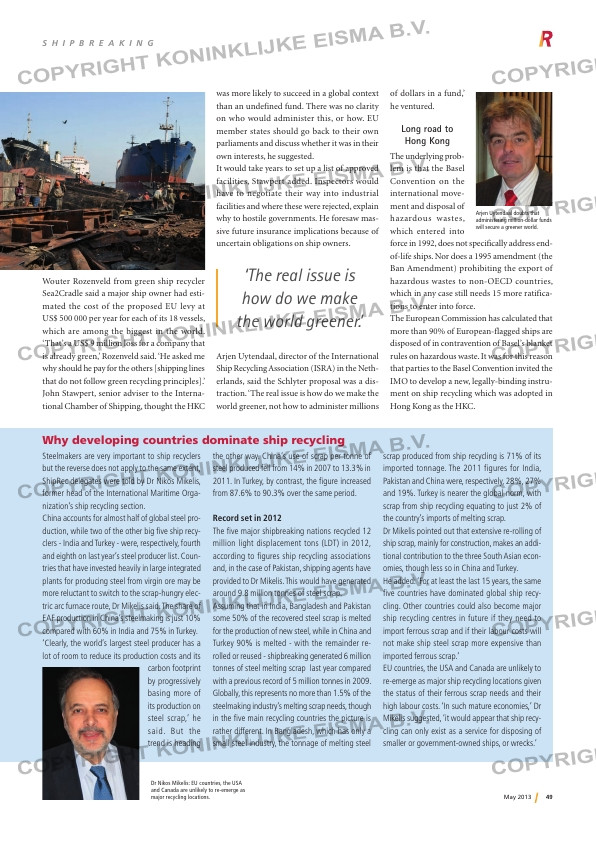Page 49 from: May 2013

49May 2013
S h i p b r e a k i n g
Wouter Rozenveld from green ship recycler
Sea2Cradle said a major ship owner had esti-
mated the cost of the proposed EU levy at
US$ 500 000 per year for each of its 18 vessels,
which are among the biggest in the world.
‘That’s a US$ 9 million loss for a company that
is already green,’ Rozenveld said. ‘He asked me
why should he pay for the others [shipping lines
that do not follow green recycling principles].’
John Stawpert, senior adviser to the Interna-
tional Chamber of Shipping, thought the HKC
was more likely to succeed in a global context
than an undefined fund. There was no clarity
on who would administer this, or how. EU
member states should go back to their own
parliaments and discuss whether it was in their
own interests, he suggested.
It would take years to set up a list of approved
facilities, Stawpert added. Inspectors would
have to negotiate their way into industrial
facilities and where these were rejected, explain
why to hostile governments. He foresaw mas-
sive future insurance implications because of
uncertain obligations on ship owners.
Arjen Uytendaal, director of the International
Ship Recycling Association (ISRA) in the Neth-
erlands, said the Schlyter proposal was a dis-
traction. ‘The real issue is how do we make the
world greener, not how to administer millions
of dollars in a fund,’
he ventured.
Long road to
Hong Kong
The underlying prob-
lem is that the Basel
Convention on the
international move-
ment and disposal of
hazardous wastes,
which entered into
force in 1992, does not specifically address end-
of-life ships. Nor does a 1995 amendment (the
Ban Amendment) prohibiting the export of
hazardous wastes to non-OECD countries,
which in any case still needs 15 more ratifica-
tions to enter into force.
The European Commission has calculated that
more than 90% of European-flagged ships are
disposed of in contravention of Basel’s blanket
rules on hazardous waste. It was for this reason
that parties to the Basel Convention invited the
IMO to develop a new, legally-binding instru-
ment on ship recycling which was adopted in
Hong Kong as the HKC.
Steelmakers are very important to ship recyclers
but the reverse does not apply to the same extent,
ShipRec delegates were told by Dr Nikos Mikelis,
former head of the International Maritime Orga-
nization’s ship recycling section.
China accounts for almost half of global steel pro-
duction, while two of the other big five ship recy-
clers – India and Turkey – were, respectively, fourth
and eighth on last year’s steel producer list. Coun-
tries that have invested heavily in large integrated
plants for producing steel from virgin ore may be
more reluctant to switch to the scrap-hungry elec-
tric arc furnace route, Dr Mikelis said. The share of
EAF production in China’s steelmaking is just 10%
compared with 60% in India and 75% in Turkey.
‘Clearly, the world’s largest steel producer has a
lot of room to reduce its production costs and its
carbon footprint
by progressively
basing more of
its production on
steel scrap,’ he
said. But the
trend is heading
the other way. China’s use of scrap per tonne of
steel produced fell from 14% in 2007 to 13.3% in
2011. In Turkey, by contrast, the figure increased
from 87.6% to 90.3% over the same period.
Record set in 2012
The five major shipbreaking nations recycled 12
million light displacement tons (LDT) in 2012,
according to figures ship recycling associations
and, in the case of Pakistan, shipping agents have
provided to Dr Mikelis. This would have generated
around 9.8 million tonnes of steel scrap.
Assuming that in India, Bangladesh and Pakistan
some 50% of the recovered steel scrap is melted
for the production of new steel, while in China and
Turkey 90% is melted – with the remainder re-
rolled or reused – shipbreaking generated 6 million
tonnes of steel melting scrap last year compared
with a previous record of 5 million tonnes in 2009.
Globally, this represents no more than 1.5% of the
steelmaking industry’s melting scrap needs, though
in the five main recycling countries the picture is
rather different. In Bangladesh, which has only a
small steel industry, the tonnage of melting steel
scrap produced from ship recycling is 71% of its
imported tonnage. The 2011 figures for India,
Pakistan and China were, respectively, 28%, 27%
and 19%. Turkey is nearer the global norm, with
scrap from ship recycling equating to just 2% of
the country’s imports of melting scrap.
Dr Mikelis pointed out that extensive re-rolling of
ship scrap, mainly for construction, makes an addi-
tional contribution to the three South Asian econ-
omies, though less so in China and Turkey.
He added: ‘For at least the last 15 years, the same
five countries have dominated global ship recy-
cling. Other countries could also become major
ship recycling centres in future if they need to
import ferrous scrap and if their labour costs will
not make ship steel scrap more expensive than
imported ferrous scrap.’
EU countries, the USA and Canada are unlikely to
re-emerge as major ship recycling locations given
the status of their ferrous scrap needs and their
high labour costs. ‘In such mature economies,’ Dr
Mikelis suggested, ‘it would appear that ship recy-
cling can only exist as a service for disposing of
smaller or government-owned ships, or wrecks.’
Dr Nikos Mikelis: EU countries, the USA
and Canada are unlikely to re-emerge as
major recycling locations.
Why developing countries dominate ship recycling
Arjen Uytendaal doubts that
administering million-dollar funds
will secure a greener world.
‘The real issue is
how do we make
the world greener.’
RI-4_Shipbreaking2.indd 49 06-05-13 14:50



